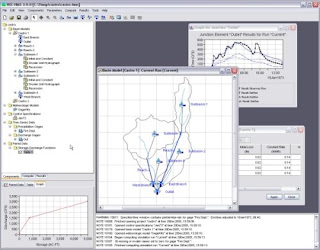
The Hydrologic Modeling System (HEC-HMS) is designed to simulate the precipitation-runoff processes of dendritic watershed systems. It is designed to be applicable in a wide range of geographic areas for solving the widest possible range of problems. This includes large river basin water supply and flood hydrology, and small urban or natural watershed runoff. Hydrographs produced by the program are used directly or in conjunction with other software for studies of water availability, urban drainage, flow forecasting, future urbanization impact, reservoir spillway design, flood damage reduction, floodplain regulation, and systems operation.
The program is a generalized modeling system capable of representing many different watersheds. A model of the watershed is constructed by separating the hydrologic cycle into manageable pieces and constructing boundaries around the watershed of interest. Any mass or energy flux in the cycle can then be represented with a mathematical model. In most cases, several model choices are available for representing each flux. Each mathematical model included in the program is suitable in different environments and under different conditions. Making the correct choice requires knowledge of the watershed, the goals of the hydrologic study, and engineering judgment.
The program features a completely integrated work environment including a database, data entry utilities, computation engine, and results reporting tools. A graphical user interface allows the seamless movement between the different parts of the program. Program functionality and appearance are the same across all supported platforms.
Contents:
Watershed Physical Description
The physical representation of a watershed is accomplished with a basin model. Hydrologic elements are connected in a dendritic network to simulate runoff processes. Available elements are: subbasin, reach, junction, reservoir, diversion, source, and sink. Computation proceeds from upstream elements in a downstream direction.
An assortment of different methods is available to simulate infiltration losses. Options for event modeling include initial constant, SCS curve number, gridded SCS curve number, exponential, and Green Ampt. The one-layer deficit constant method can be used for simple continuous modeling. The five-layer soil moisture accounting method can be used for continuous modeling of complex infiltration and evapotranspiration environments. Gridded methods are available for both the deficit constant and soil moisture accounting methods.
Several methods are included for transforming excess precipitation into surface runoff. Unit hydrograph methods include the Clark, Snyder, and SCS techniques. User-specified unit hydrograph or s-graph ordinates can also be used. The modified Clark method, ModClark, is a linear quasi-distributed unit hydrograph method that can be used with gridded meteorologic data. An implementation of the kinematic wave method with multiple planes and channels is also included.
Multiple methods are included for representing baseflow contributions to subbasin outflow. The recession method gives an exponentially decreasing baseflow from a single event or multiple sequential events. The constant monthly method can work well for continuous simulation. The linear reservoir method conserves mass by routing infiltrated precipitation to the channel.
A variety of hydrologic routing methods are included for simulating flow in open channels. Routing with no attenuation can be modeled with the lag method. The traditional Muskingum method is included along with the straddle stagger method for simple approximations of attenuation. The modified Puls method can be used to model a reach as a series of cascading, level pools with a user-specified storage-discharge relationship. Channels with trapezoidal, rectangular, triangular, or circular cross sections can be modeled with the kinematic wave or Muskingum-Cunge methods. Channels with overbank areas can be modeled with the Muskingum-Cunge method and an 8-point cross section.
Water impoundments can also be represented. Lakes are usually described by a user-entered storage-discharge relationship. Reservoirs can be simulated by describing the physical spillway and outlet structures. Pumps can also be included as necessary to simulate interior flood area. Control of the pumps can be linked to water depth in the collection pond and, optionally, the stage in the main channel.
Meteorology Description
Meteorologic data analysis is performed by the meteorologic model and includes precipitation, evapotranspiration, and snowmelt. Six different historical and synthetic precipitation methods are included. Two evapotranspiration methods are included at this time. Currently, only one snowmelt method is available.
Four different methods for analyzing historical precipitation are included. The user-specified hyetograph method is for precipitation data analyzed outside the program. The gage weights method uses an unlimited number of recording and non-recording gages. The Thiessen technique is one possibility for determining the weights. The inverse distance method addresses dynamic data problems. An unlimited number of recording and non-recording gages can be used to automatically proceed when missing data is encountered. The gridded precipitation method uses radar rainfall data.
Four different methods for producing synthetic precipitation are included. The frequency storm method uses statistical data to produce balanced storms with a specific exceedance probability. Sources of supporting statistical data include Technical Paper 40 and NOAA Atlas 2. While it was not specifically designed to do so, data can also be used from NOAA Atlas 14. The standard project storm method implements the regulations for precipitation when estimating the standard project flood. The SCS hypothetical storm method implements the primary precipitation distributions for design analysis using Natural Resources Conservation Service (NRCS) criteria. The user-specified hyetograph method can be used with a synthetic hyetograph resulting from analysis outside the program.
Potential evapotranspiration can be computed using monthly average values. There is also an implementation of the Priestley-Taylor method that includes a crop coefficient. A gridded version of the Priestley-Taylor method is also available.
Snowmelt can be included for tracking the accumulation and melt of a snowpack. A temperature index method is used that dynamically computes the melt rate based on current atmospheric conditions and past conditions in the snowpack.
Hydrologic Simulation
The time span of a simulation is controlled by control specifications. Control specifications include a starting date and time, ending date and time, and a time interval.
A simulation run is created by combining a basin model, meteorologic model, and control specifications. Run options include a precipitation or flow ratio, capability to save all basin state information at a point in time, and ability to begin a simulation run from previously saved state information.
Simulation results can be viewed from the basin map. Global and element summary tables include information on peak flow and total volume. A time-series table and graph are available for elements. Results from multiple elements and multiple simulation runs can also be viewed. All graphs and tables can be printed.
Parameter Estimation
Most parameters for methods included in subbasin and reach elements can be estimated automatically using optimization trials. Observed discharge must be available for at least one element before optimization can begin. Parameters at any element upstream of the observed flow location can be estimated. Six different objective functions are available to estimate the goodness-of-fit between the computed results and observed discharge. Two different search methods can be used to minimize the objective function. Constraints can be imposed to restrict the parameter space of the search method.
Analyzing Simulations
Analysis tools are designed to work with simulation runs to provide additional information or processing. Currently, the only tool is the depth-area analysis tool. It works with simulation runs that have a meteorologic model using the frequency storm method. Given a selection of elements, the tool automatically adjusts the storm area and generates peak flows represented by the correct storm areas.
GIS Connection
The power and speed of the program make it possible to represent watersheds with hundreds of hydrologic elements. Traditionally, these elements would be identified by inspecting a topographic map and manually identifying drainage boundaries. While this method is effective, it is prohibitively time consuming when the watershed will be represented with many elements. A geographic information system (GIS) can use elevation data and geometric algorithms to perform the same task much more quickly. A GIS companion product has been developed to aid in the creation of basin models for such projects. It is called the Geospatial Hydrologic Modeling Extension (HEC-GeoHMS) and can be used to create basin and meteorologic models for use with the program.


No comments:
Post a Comment